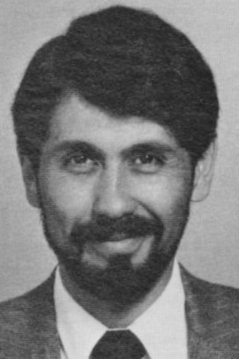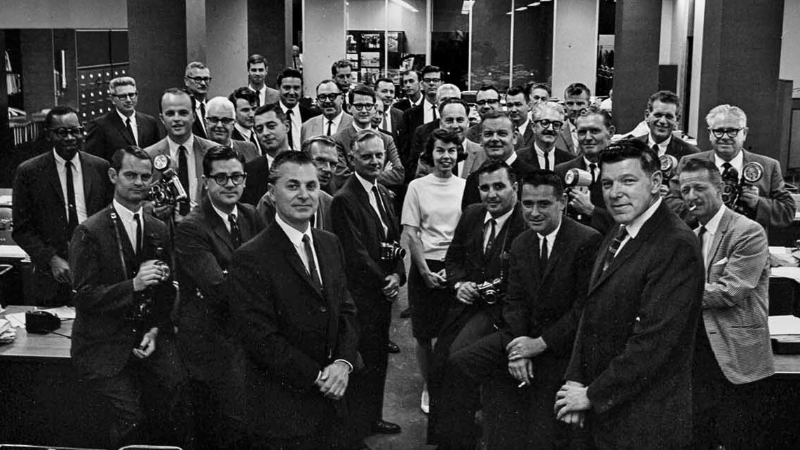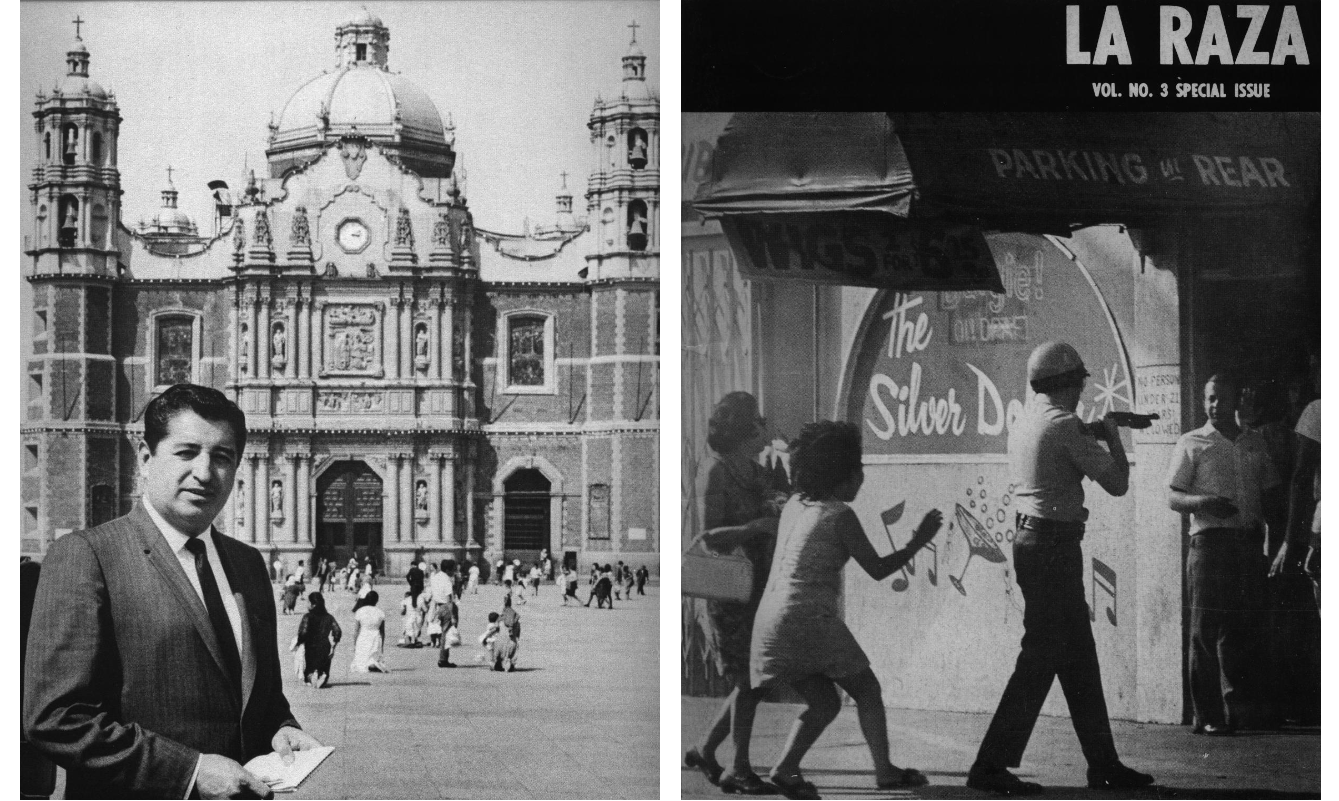For the first 60-plus years of the 20th century, the Los Angeles Times was no friend of Mexicans and Mexican Americans. The newspaper came under the control of Harry Chandler upon the death of his father-in-law, Gen. Harrison Gray Otis, in 1917. The newspaper family owned a large ranch in Baja California and during the Mexican Revolution and its aftermath, it meddled in Mexico’s politics in an effort to preserve ownership.The newspaper family owned a large ranch in Baja California and during the Mexican Revolution and its aftermath, it meddled in Mexico’s politics in an effort to preserve ownership.
In Los Angeles, the Times consistently took positions that ran counter to the interests of Mexican American working people. For instance, it staunchly opposed labor unions, even more avidly after its building was bombed in 1910 by union activists, killing 21 newspaper employees. Times’ news coverage either ignored Mexican Americans or tended to cover them in stereotypical terms. In some instances, it demonized them and made them scapegoats.

Some older Mexican Americans vowed never to allow the Times to enter their homes. They knew the history of the Times and its relationship with the Mexican-origin population of Los Angeles. During the Great Depression, for example, the Times fed a media hysteria that made scapegoats of Mexicans for supposedly being a drain on California’s economy. Hundreds of thousands of Mexicans who were quietly working and raising families were forcibly repatriated by public and private agencies. Even some legal residents and U.S.-born citizens were pushed out of their homes and country. The family of Victor Valle, one of the Latino series team writers, was well aware of his family’s struggles because of the Times’ tirades against Mexicans.
Valle, now professor emeritus at California Polytechnic State University, San Luis Obispo, offered this recollection in a recent email: “I come from a politically active family that kept score, historically speaking, of what the Chandlers had done in L.A. going back to the Mexican Revolution. [During the repatriation period], “they whipped the hysteria that forced my grandmother and my dad to return to Mexico and lose their legal residency.”
It was years, Valle said, “before my grandmother, my father and his brothers could be reunited with their sister,” who had stayed in the United States.
A decade later, the Times and the Hearst newspapers of L.A. aroused hysteria again, this time accusing young Mexican Americans of being delinquents not supportive of the World War II effort. That same type of frenzy had spurred U.S. authorities to force Japanese Americans into internment camps after the attack on Pearl Harbor. In the infamous 1942 Sleepy Lagoon trial, a group of young Mexican American men were wrongly convicted in a racist-filled murder trial. They served prison terms before their conviction was reversed.
In the same xenophobic atmosphere, U.S. sailors and soldiers rushed into L.A. in 1943 and beat up young Mexican American men on the streets and in movie theaters, singling out those who wore the popular zoot suits. Even after that blatant vigilante action by the sailors, a June 7 Times headline declared: “Zoot Suiters Learn Lesson in Fights With Servicemen.” Because of the sailors’ illegal actions, I call those dark days the “1943 sailors’ rampage.”Because of the sailors’ illegal actions, I call those dark days the “1943 sailors’ rampage.”
The Times not only consistently endorsed hard-core Republican candidates but also sought out potential candidates for office. Some Chandler family members were ardent followers of the reactionary John Birch Society. The newspaper, pre-1960, “was an openly partisan mouthpiece for the conservative wing of the Republican Party,” according to a 2002 description of the paper published in the Times.The newspaper, pre-1960, “was an openly partisan mouthpiece for the conservative wing of the Republican Party,” according to a 2002 description of the paper published in the Times.
Working with a potful of money
In 1960, Otis Chandler took over as publisher from his father, Norman. He vowed to change the Times, often cited as one of the nation’s worst newspapers, into a nonpartisan, independent, world-class newspaper. Times editor Nick B. Williams, working with a potful of Times money, hired talented reporters and editors from across the country. The newspaper’s transformation was dramatic; by 1970, it ranked as one of the nation’s best. However, the Times’ relationship with its minority communities remained troubled. It largely ignored coverage of those communities except to report on crime.
The Times was not alone in its flawed coverage of people of color. It was generally true for all newspapers across the country, wrote professors Clint C. Wilson II, Félix Gutiérrez and Lena M. Chao in their book “Racism, Sexism and the Media.”It was generally true for all newspapers across the country, wrote professors Clint C. Wilson II, Félix Gutiérrez and Lena M. Chao in their book “Racism, Sexism and the Media.” The authors state that racial minorities all too often were portrayed as “problem people; that is, as groups either beset by problems or causing them for the larger society.”
Series reporter Virginia Escalante, now a professor at San Diego City College, offered this reflection: “Whenever I watched television, when I read newspapers, it was very disconcerting because usually I couldn’t find anyone with whom I could identify. If media did cover our people, it was through this very fractured, distorted lens.”
What effects did the barrage of negative depictions of Mexican Americans have on establishing or reinforcing other people’s attitudes toward them?
Wilson, Gutiérrez and Chao addressed the question this way (page 47): “Because of the wide range of social and psychological factors that affect how a person thinks and acts, it is difficult to pinpoint the specific effects of the media on individuals.… Nevertheless, studies have shown that negative, one-sided or stereotyped portrayals and news coverage in the media very often reinforce racist attitudes in prejudiced members of the audience and can channel mass actions against the group being portrayed stereotypically.”
White men and typewriters
When Otis Chandler took over as publisher in 1960, the Times’ newsroom could almost be mistaken for the setting for the 1930s film “The Front Page.” Men in stiff white shirts worked at large desks, pounding out stories on clanking typewriters. Cigarette smoke swirled around editors, who stood up periodically to sharpen their brown editing pencils. The local reporting staff was 99% white men—it had always been that way and perhaps in the minds of certain staff members, it would always stay that way.
The lack of racial and gender diversity in the Times’ newsroom was all too typical of daily newspapers in that era. Some crusading newspaper editors courageously lashed out at segregation and bigotry in the Deep South during the 1960s civil rights era. Little was said or written, however, about the situation in U.S. newsrooms, which were among America’s most segregated workplaces.
No one at the Times seemed concerned about staff diversity. In fact, the word “diversity” was not used at all. Then on August 11, 1965, the Watts riots erupted just a few miles south of the Times’ building, jarring the editors into a harsh reality. The rebellion had broken out after the arrest of a black motorist in the predominantly African American neighborhood of South L.A. The area simmered in resentment of the police, of housing and employment discrimination and of the neglect it had endured from the government and the white power structure.
Not a single black reporter
White reporters covered the early stages of the unrest and returned during daytime hours on subsequent days, but more than one Times writer was threatened and chased away by angry rioters. Reporter Phil Fradkin was hospitalized after being clobbered on the shoulder with a brick. Times editors realized that the newspaper’s news-gathering ability would be enhanced by having an African American reporter familiar with the area reporting from the scene. Yet there was not a single black journalist on staff.
Robert Richardson, a 24-year-old black man who worked in a Times advertising department, walked into the newsroom and volunteered to report from Watts. The editors accepted his offer. Amid the gunshots and burning storefronts, he ducked into phone booths and called in what he saw to rewrite men who put together the riot stories. When the embers of six days of rioting finally cooled, 34 people had been killed and $40 million in property damage had been inflicted.
Soon after the riots, the Times dispatched a newsroom team, led by Jack Jones, an outstanding white reporter, to Watts to search out the underlying reasons for the rioting and to report on the views of people there. In a seven-part series, “The View From Watts,” the Times discovered deplorable conditions in South L.A., including 13 area schools that had no cafeterias, a lack of county health clinics and limited transportation services to get to jobs. One person after another told of being turned down for jobs for which they were more than qualified.
Supplementing the spot news coverage of the rioting, the “The View From Watts” helped the Times win the 1966 Pulitzer Prize for local reporting.

The Times was a-changin’
In a 2005 interview with Times reporter Valerie Reitman for a story on the Watts riots, veteran Times reporter Eric Malnic recalled:
“We’d never covered the black community. As far as we were concerned, it didn't exist. We didn't quote anyone or solicit opinions. For the first time [after Watts], we tried to go down and find out who was doing what.… And for the first time, we had the audacity to question what the police did.…
“It changed everything, man, it really changed everything. It didn't happen overnight. We’d never had a black reporter. We had one woman, Dorothy Townsend [in local news], who wasn’t allowed to cover the riots. The newsroom was basically white middle-class males.
“Minorities started being paid attention to,” Malnic continued. “People stopped using pejorative terms for ethnic groups in the city room.… [Before] it was always pejoratives. Blacks were niggers, Latinos were spics, Jews were kikes. I was a jug because I was a Slav. This was the way you talked.”“Minorities started being paid attention to,” Malnic continued. “People stopped using pejorative terms for ethnic groups in the city room.… [Before] it was always pejoratives. Blacks were niggers, Latinos were spics, Jews were kikes. I was a jug because I was a Slav. This was the way you talked.”
Richardson let go
After the rioting, Robert Richardson took a pay cut to become a reporter trainee, but he was fired in connection with a misdemeanor charge later dropped. Years later, Richardson said he had been let go because of a drinking problem.
Later, Ray Rogers, a black reporter, was hired on the Metro staff. Unlike Richardson, who lacked any journalism training, Rogers arrived with strong credentials. However, he did not last long.
In August of 1967, then-City Editor Bill Thomas hired William Drummond, an African American with a master’s degree in journalism from Columbia University. He excelled not only as a local reporter but also later as a correspondent in India, Israel and Washington.
Some people saw Thomas as cold, private and aloof. Drummond, now a journalism professor at University of California Berkeley, praised him in a recent email as “by far the best editor, boss, friend I ever had in journalism.”
The rise of Ruben Salazar
Six years before the Watts riots, the Times had taken a positive step in Mexican American coverage, hiring Ruben Salazar in 1959. Not wanting to be limited to ethnic assignments, Salazar covered stories across the board, including insightful articles in 1963 assessing the status of Mexican Americans in Los Angeles. In 1965, Salazar became a foreign correspondent and was posted in Vietnam and later in Mexico City.
While Salazar was reporting in Mexico, the Chicano Movement erupted in 1968 amid a turbulent decade of other protests. As demonstrators in the civil rights movement before them had done, a younger segment of the Mexican American population took to the streets to underscore their social and political grievances. Mexican Americans in L.A. felt powerless politically, without a single City Council member or county supervisor of their ethnicity. Some were victims of housing covenants that restricted where they could live or of barriers that restricted where they could work. Situated far from East Coast power brokers and image makers, they were sometimes referred to as the “Forgotten People.”
As the protests heated up in 1969, Times editors directed Ruben Salazar to leave his Mexico City post and to return to L.A. to cover the Mexican American community. By then, the Chicano Movement had spread across the Southwest, and Salazar kept a travel bag handy as he followed developments across California and from Colorado to Texas. Mexican Americans took notice of Salazar’s stories because, for once, the city’s main news media outlet was paying attention.
In early 1970, Salazar took the job as news director at KMEX, a fledging L.A. Spanish-language TV station. But Salazar agreed to write a weekly commentary for the Times on issues concerning Mexican Americans. As a columnist, Salazar no longer was bound by the reporter’s code of objectivity. He used his wide experience and contacts to write forcefully about Mexican Americans, often taking to task police, judges and school administrators. But beyond being a critic, Salazar, for the first time in a mainstream newspaper, informed the public about what Mexican Americans were thinking and positive things they were doing.
In early 1970, a friend mailed some of Salazar’s columns to me. I had been drafted and was in the Army in Japan. He became an inspiration for me, a young Chicano during an era with few minorities in the news media. As I prepared to leave the Army, I had options, including a job possibility at the Washington Post.As I prepared to leave the Army, I had options, including a job possibility at the Washington Post. But I wanted to work at the L.A. Times because of Salazar. I vowed to go to L.A. and meet him. On Aug. 29, 1970, I got my military discharge in Oakland and looked forward to a Times job interview. Little did I know what would occur in L.A. on that same Saturday.
On that Aug. 29, Salazar watched as 25,000 Mexican Americans protested the Vietnam War and the disproportionate number of Mexican Americans being drafted and killed. Later, a small skirmish occurred at the outskirts of Laguna Park, where the demonstrators had gathered. Sheriff’s deputies used that as a reason to break up the protest, firing tear gas into the crowd. People scattered. Angry that their rally had been broken up, groups of Chicanos went on a rampage along Whittier Boulevard, breaking windows and setting stores ablaze.
Salazar and a KMEX colleague, Guillermo Restrepo, walked into The Silver Dollar, a dingy bar miles from the disturbance. Salazar believed they were being followed, Restrepo later said. Sheriff's deputies suddenly appeared outside the bar. Deputy Thomas Wilson fired a 10-inch projectile filled with tear gas through the bar’s open door. The projectile struck Salazar in the head. When the gas cleared, deputies found the most prominent Mexican American journalist in history on the floor. Dead.
More than a month later, I went to the Times for an interview. I wanted to be a reporter, perhaps to report on topics Salazar had once covered, but I was told that there were no reporter openings. Instead, I was given a tryout as a copy editor and, by week’s end, I was hired.

An indecisive hearing
During that same week, a rarely used legal hearing—a Coroner’s Department inquest—was under way. Mexican American activists suspected that Salazar, who had been sharply critical of law enforcement, had been targeted and killed to silence him.
After 16 days of televised testimony, the majority of jurors ruled that Salazar “died at the hands of another.” No kidding! No one knew exactly what that ruling meant. Shortly after, District Attorney Evelle J. Younger announced that no criminal charges would be filed against Wilson. The Times deplored the killing but did not launch an all-out investigative effort.
The mystery surrounding Salazar’s death lurked for 40 years: Was it an accident or an assassination? In 2010, filmmaker Phillip Rodriguez and Times reporter Robert Lopez separately pressed the Sheriff’s Department for release of unredacted files about the Salazar slaying. When the Mexican American Legal Defense and Educational Fund filed a lawsuit on behalf of Rodriguez, the Sheriff’s Department finally relented. Rodriguez was granted access to all of the Salazar files in the Sheriff’s Department possessions.
“A colossal and tragic mistake”
A civilian watchdog agency, the Office of Independent Review, investigated the available evidence and concluded that the shooting of Salazar was a colossal and tragic mistake. Rodriguez’s PBS film, “Man in the Middle,” provided new information and perspectives but came to the same conclusion.
Salazar was only 42. His death represented a profound tragedy, most of all for his wife, Sally, and their three children. In a more general sense, his death represented a setback for the Times’ relationship with the Mexican American community. To partly fill the void, the Times hired Frank del Olmo, who had worked earlier that summer of 1970 as a reporter intern and had gotten to know Salazar.
Soon after Salazar was killed, parks, libraries and schools were named in his honor. For those of us in journalism, Salazar became an inspiration and an icon for a generation of Latino reporters. Many of us who worked on the 1983 Latino series were inspired by his example.